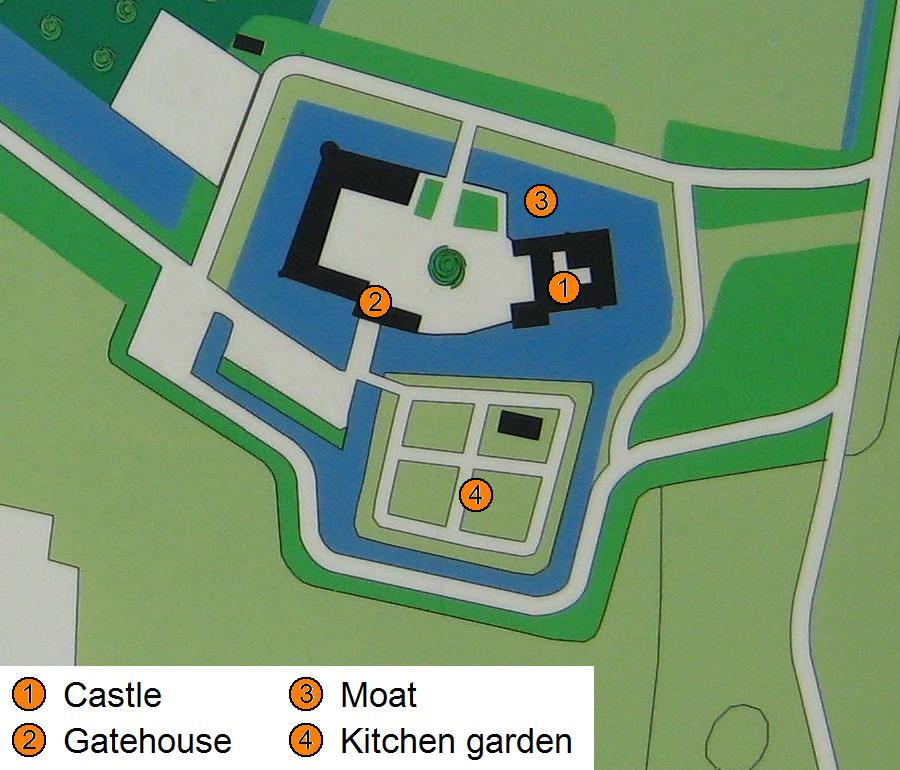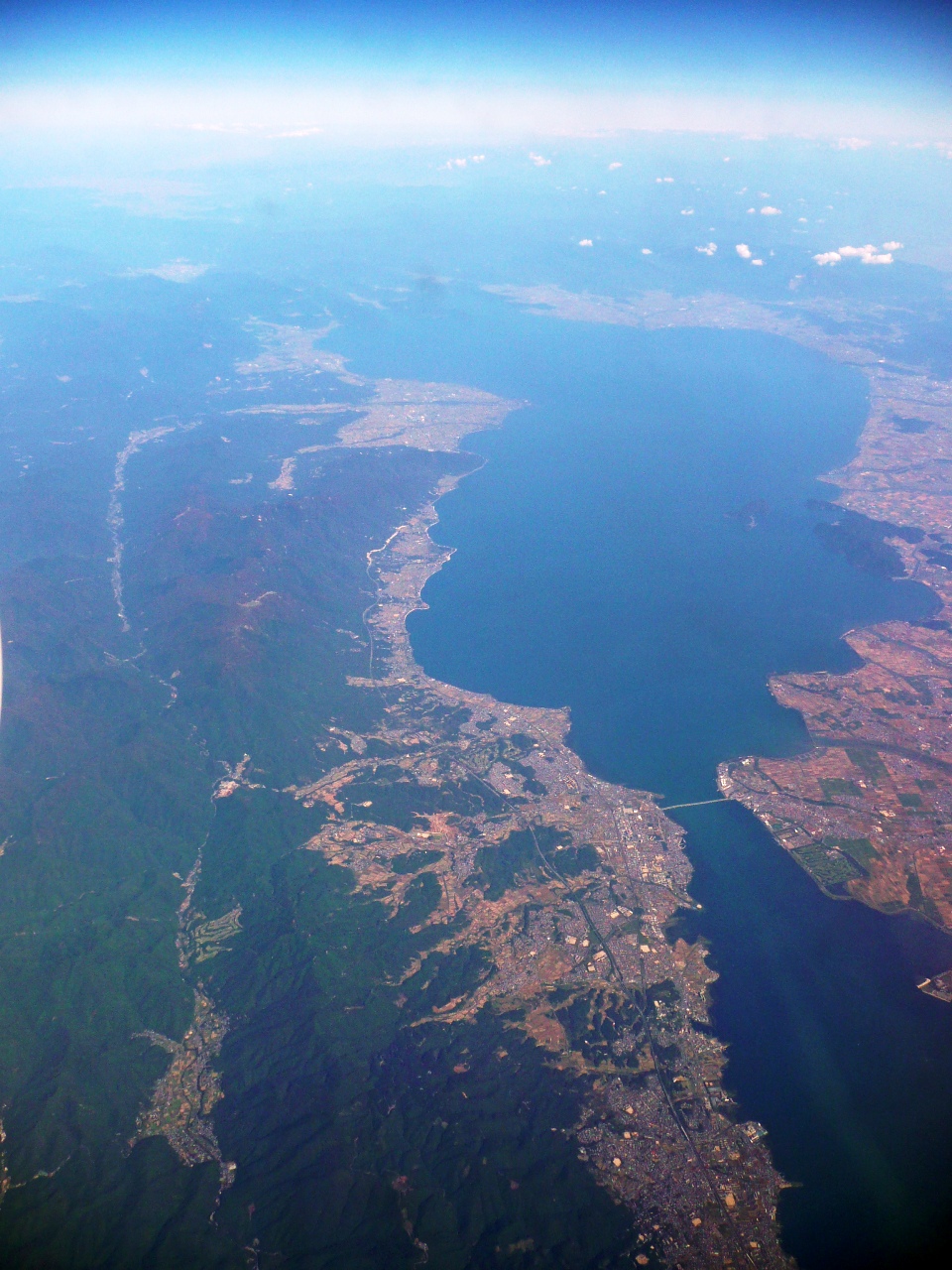|
Sakamoto Castle
was a lakeside castle in the Sengoku period, located in Ōtsu, Shiga Prefecture, Japan. Akechi Mitsuhide was the commander of the castle. History After the Siege of Mount Hiei, Sakamoto was given to Akechi Mitsuhide who built Sakamoto Castle under orders from the warlord Oda Nobunaga because Sakamoto was a strategically important place to rule. Luís Fróis described the castle as the second best castle in Japan at the time. After the loss of Battle of Yamazaki, Mitsuhide tried to return to the castle but he was killed on the way. Surrounded by Toyotomi's army, Mitsuhide's adopted son Akechi Hidemitsu set fire to the castle and killed himself. In 1583, Sakamoto castle was given to Niwa Nagahide and he rebuilt the castle. In 1586, Asano Nagamasa abandoned the castle and moved to Ōtsu Castle by Toyotomi Hideyoshi's order. (Stones and materials were transferred to Ōtsu Castle.) Nowadays nothing remains of the original castle, and a statue of Akechi Mitsuhide stands in Sak ... [...More Info...] [...Related Items...] OR: [Wikipedia] [Google] [Baidu] |
Battle Of Yamazaki
The was fought in 1582 in Shimamoto, Osaka, Yamazaki, Japan, located in current-day Kyoto Prefecture. This battle is sometimes referred to as the Battle of Mt. Tennō (天王山の戦い ''Tennō-zan no tatakai''). In the Honnō-ji Incident, Akechi Mitsuhide, a retainer of Oda Nobunaga, attacked Nobunaga as he rested in Honnō-ji, and forced him to commit ''seppuku''. Mitsuhide then took over Nobunaga's power and authority around the Kyoto area. Thirteen days later, Oda's forces under Toyotomi Hideyoshi met Mitsuhide at Yamazaki and defeated him, avenging his lord (Nobunaga) and taking Nobunaga's authority and power for himself. Background Honnō-ji Incident Incident at Honnō-ji, When Nobunaga died, Hideyoshi was busy fighting the Mōri clan in the Siege of Takamatsu. After betraying and defeating Nobunaga at Honnō-ji, Mitsuhide sent a letter to the Mōri. The letter contained a request for an alliance to crush Hideyoshi, but the letter's messenger was intercepted by Hidey ... [...More Info...] [...Related Items...] OR: [Wikipedia] [Google] [Baidu] |
Water Castles
A water castle is a castle whose site is largely defended by water. It can be entirely surrounded by water-filled moats (moated castle) or natural waterbodies such as island castles in a river or offshore. The term comes from European castle studies, mainly German ''Burgenkunde'', but is sometimes used in English-language popular science books and websites, and is mentioned in other more academic works. When stately homes were built in such a location, or a Wasserburg was later rebuilt as a residential manor, the German term becomes Wasserschloss, lit. "water palace/manor". Description Forde-Johnston describes such a site as "a castle in which water plays a prominent part in the defences." Apart from hindering attackers, an abundant supply of water was also an advantage during a siege. Topographically, such structures are a type of low-lying castle. Such a castle usually had only one entrance, which was via a drawbridge and that could be raised for protection in the event of a ... [...More Info...] [...Related Items...] OR: [Wikipedia] [Google] [Baidu] |
Ruined Castles In Japan
Ruins () are the remains of a civilization's architecture. The term refers to formerly intact structures that have fallen into a state of partial or total disrepair over time due to a variety of factors, such as lack of maintenance, deliberate destruction by humans, or uncontrollable destruction by natural phenomena. The most common root causes that yield ruins in their wake are natural disasters, armed conflict, and population decline, with many structures becoming progressively derelict over time due to long-term weathering and scavenging. There are famous ruins all over the world, with notable sites originating from ancient China, the Indus Valley and other regions of ancient India, ancient Iran, ancient Israel and Judea, ancient Iraq, ancient Greece, ancient Egypt, Roman sites throughout the Mediterranean Basin, and Incan and Mayan sites in the Americas. Ruins are of great importance to historians, archaeologists and anthropologists, whether they were once individual fort ... [...More Info...] [...Related Items...] OR: [Wikipedia] [Google] [Baidu] |
Former Castles In Japan
A former is an object, such as a template, gauge or cutting die, which is used to form something such as a boat's hull. Typically, a former gives shape to a structure that may have complex curvature. A former may become an integral part of the finished structure, as in an aircraft fuselage, or it may be removable, being using in the construction process and then discarded or re-used. Aircraft formers Formers are used in the construction of aircraft fuselage, of which a typical fuselage has a series from the nose to the empennage, typically perpendicular to the longitudinal axis of the aircraft. The primary purpose of formers is to establish the shape of the fuselage and reduce the column length of stringers to prevent instability. Formers are typically attached to longerons, which support the skin of the aircraft. The "former-and-longeron" technique (also called stations and stringers) was adopted from boat construction, and was typical of light aircraft built until the ad ... [...More Info...] [...Related Items...] OR: [Wikipedia] [Google] [Baidu] |
Castles In Shiga Prefecture
A castle is a type of fortified structure built during the Middle Ages predominantly by the nobility or royalty and by military orders. Scholars debate the scope of the word ''castle'', but usually consider it to be the private fortified residence of a lord or noble. This is distinct from a palace, which is not fortified; from a fortress, which was not always a residence for royalty or nobility; from a ''pleasance'' which was a walled-in residence for nobility, but not adequately fortified; and from a fortified settlement, which was a public defence – though there are many similarities among these types of construction. Use of the term has varied over time and has also been applied to structures such as hill forts and 19th-20th century homes built to resemble castles. Over the approximately 900 years when genuine castles were built, they took on a great many forms with many different features, although some, such as curtain walls, arrowslits, and portcullises, were ... [...More Info...] [...Related Items...] OR: [Wikipedia] [Google] [Baidu] |
Akechi Clan
The is a branch of the Toki clan, which is descended from the Seiwa Genji. The Akechi clan thrived around the later part of the Sengoku period of the 16th century. The Akechi became the head, soryo of the Toki after the Toki fell to the Saitō clan in 1540. The Akechi refused to be under Saitō Yoshitatsu who attacked Nagayama castle. Akechi Mitsuhide then served shoguns Ashikaga Yoshiteru and Ashikaga Yoshiaki. After introducing Ashikaga Yoshiaki to Oda Nobunaga, Mitsuhide became a powerful general under Oda Nobunaga. However, after 1582, Mitsuhide trapped Nobunaga at Honnō-ji and forced him to commit suicide. The Akechi then gained power due to the collapse of the Oda clan. Later that same year, Akechi Mitsuhide was slain at the Battle of Yamazaki, twelve days after the Incident at Honnō-ji. The Akechi clan then fell from prominence. Important figures * Akechi Mitsutsugu, grandfather of Akechi Mitsuhide. Mitsutsugu was father of Omi-no-kata, Saito Dosan wife. * Akechi Mitsut ... [...More Info...] [...Related Items...] OR: [Wikipedia] [Google] [Baidu] |
Lake Biwa
is the largest freshwater lake in Japan, located entirely within Shiga Prefecture (west-central Honshu), northeast of the former capital city of Kyoto. Lake Biwa is an ancient lake, over 4 million years old. It is estimated to be the 13th oldest lake in the world. Because of its proximity to Kyoto, references to Lake Biwa appear frequently in Japanese literature, particularly in poetry and in historical accounts of battles. Name The name ''Biwako'' was established in the Edo period. There are various theories about the origin of the name ''Biwako'', but it is generally believed to be so named because of the resemblance of its shape to that of a stringed instrument called the ''biwa''. Kōsō, a learned monk of Enryaku-ji in the 14th century, gave a clue to the origin of the name ''Biwako'' in his writing: "The lake is the Pure land of the goddess Benzaiten because she lives on Chikubu Island and the shape of the lake is similar to that of the ''biwa'', her favorite instrume ... [...More Info...] [...Related Items...] OR: [Wikipedia] [Google] [Baidu] |
Toyotomi Hideyoshi
, otherwise known as and , was a Japanese samurai and ''daimyō'' (feudal lord) of the late Sengoku period regarded as the second "Great Unifier" of Japan.Richard Holmes, The World Atlas of Warfare: Military Innovations that Changed the Course of History, Viking Press 1988. p. 68. Hideyoshi rose from a peasant background as a Affinity (medieval), retainer of the prominent lord Oda Nobunaga to become one of the most powerful men in Japan. Hideyoshi succeeded Nobunaga after the Honnō-ji Incident in 1582 and continued Nobunaga's campaign to unite Japan that led to the closing of the Sengoku period. Hideyoshi became the ''de facto'' leader of Japan and acquired the prestigious positions of Daijō-daijin, Chancellor of the Realm and Sesshō and Kampaku, Imperial Regent by the mid-1580s. Hideyoshi launched the Japanese invasions of Korea (1592–1598), Japanese invasions of Korea in 1592 to initial success, but eventual military stalemate damaged his prestige before his death in 1 ... [...More Info...] [...Related Items...] OR: [Wikipedia] [Google] [Baidu] |
Ōtsu Castle
270px, Ōtsu City Hall is the capital city of Shiga Prefecture, Japan. , the city had an estimated population of 343,991 in 153458 households and a population density of 740 persons per km². The total area of the city is . Geography Ōtsu is located on the southern and southeastern shore of Lake Biwa and occupies most of the southeastern portion of Shiga Prefecture. The city is "L"-shaped and stretches along the southwest shore of Lake Biwa, Japan's largest lake. Ōtsu ranges from the densely populated alluvium depressions near the shore of Lake Biwa to sparsely populated hilly and mountainous areas to the west (Hira Mountains and Mount Hiei) and south of the city. Mount Hiei to the east forms the border of the city and Shiga Prefecture with Kyoto. Neighboring municipalities Shiga Prefecture * Kusatsu * Rittō * Kōka * Takashima Kyoto Prefecture *Kyoto *Uji * Ujitawara Climate Ōtsu has a Humid subtropical climate (Köppen ''Cfa'') characterized by warm summers and co ... [...More Info...] [...Related Items...] OR: [Wikipedia] [Google] [Baidu] |
Akechi Hidemitsu
was a Japanese samurai of the Sengoku period. A senior retainer of Oda Nobunaga's vassal Akechi Mitsuhide, he served Mitsuhide until the latter's death in 1582 at the hands of Toyotomi Hideyoshi. He is also known as Akechi Mitsuharu. Early life and family While Hidemitsu's date of birth is not known for certain, he was born either sometime between 1535 and 1537, or as late as 1557. Hidemitsu was the son of Tōyama Kageyuki (lord of Myōchi Castle) and Miyake Takasada (lord of Hirose Castle in Mikawa Province). He first succeeded to his father, taking the name Tōyama Kageharu (common name Rokurōzaemon); then he succeeded to his mother's birth family under the name Miyake Yaheiji, and then, marrying one of Akechi Mitsuhide's daughters, took the name Akechi Hidemitsu. Service to Mitsuhide and death Following his marriage to Akechi Mitsuhide's daughter (who had been formerly married to Araki Murashige), Hidemitsu was deeply trusted by his master, and served in the vanguard of ... [...More Info...] [...Related Items...] OR: [Wikipedia] [Google] [Baidu] |








